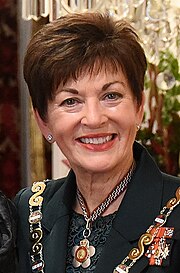Governor General of New Zealand
| Governor-General of New Zealand Te Kāwana Tianara o Aotearoa |
|
|---|---|

Coat of Arms of New Zealand
|
|

|
|
| Viceroy | |
| Style | His/Her Excellency the Right Honourable |
| Residence | Government House, Wellington |
| Nominator | Prime Minister of New Zealand |
| Appointer | Monarch of New Zealand |
| Term length | At His/Her Majesty's pleasure (usually 5 years by convention) |
| Formation | 3 May 1841 |
| First holder |
William Hobson as Governor of New Zealand |
| Salary | NZ$354,000 |
| Website | gg.govt.nz |
The Governor-General of New Zealand (Māori: Te Kāwana Tianara o Aotearoa) is the viceregal representative of the monarch of New Zealand, currently Queen Elizabeth II. Because the monarch is shared equally with the 15 other Commonwealth realms, and normally resides in the United Kingdom, she, on the advice of the prime minister, appoints a governor-general to carry out most of constitutional and ceremonial duties within the Realm of New Zealand.
The office is mandated by letters patent and the officeholder is formally titled "the Governor-General and Commander-in-Chief of the Realm of New Zealand". Constitutional functions of the governor-general include presiding over the Executive Council, appointing ministers and judges, dissolving parliament, granting Royal Assent to legislation, issuing writs for elections and bestowing honours. Beyond constitutional functions, the governor-general has an important ceremonial role: hosting events at Government House in Wellington, and travelling throughout New Zealand to open conferences, attend services and commemorations. When travelling abroad, the governor-general is seen as the representative of New Zealand, and of the Queen of New Zealand. For this reason, the governor-general is viewed by some as the de facto head of state. Under the Niue Constitution Act, the governor-general also represents the monarch in Niue.
...
Wikipedia

